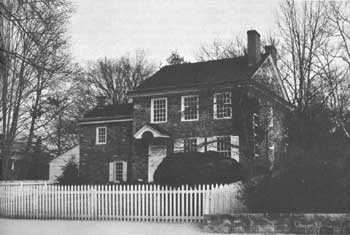





Survey of
Historic Sites and Buildings
 |
VALLEY FORGE NATIONAL HISTORICAL PARK Pennsylvania |
 Valley Forge NHP |
| ||
Significance. No name in American history conveys more of suffering, sacrifice, and triumph than Valley Forge. Washington's ragged, hungry troops staggered into the camp on December 19, 1777, the wreckage of a defeated army. They endured a bitterly cold and uncomfortable winter, but emerged as a trained army. The military training and discipline imposed at Valley Forge created a force that would meet the enemy on equal terms from then on, and at last defeat him.
 |
| General Washington used this house as his headquarters while the army was encamped at Valley Forge. (National Park Service) |
Washington's 11,000 troops were mostly unfit for service when he took them into winter quarters at Valley Forge. They had experienced a series of fruitless marches and costly skirmishes, capped by defeat at Brandywine and failure at Germantown. From this camp, named for a small iron mill on Valley Creek which the British had destroyed, the Army could defend itself and also observe the approaches to Philadelphia. Approximately 900 log huts were raised, and fortifications were thrown up to protect the camp and command nearby roads and rivers. The soldiers were not permitted to huddle in their cabins, but were rigorously drilled and disciplined by "Baron" Frederick von Steuben who, even if he magnified his European rank and title, was nevertheless a drillmaster of surpassing skill. When spring came the Army was ready for the field as never before, and at Monmouth on June 28, 1778, it made its debut as a skilled force able to meet and defeat British regulars in open combat.
Present Appearance. Covering 2,000 acres and known as Valley Forge State Park until July 4, 1976 when it was incorporated into the National Park System as Valley Forge National Historical Park, the park now embraces over 3,400 acres on both sides of the Schuylkill River. It includes extensive remains of the major forts, lines of earthworks, the artillery park, Washington's head quarters house, quarters of other top officers, and the grand parade ground, where Von Steuben rebuilt the Army and where news of the French alliance was announced on May 6, 1778. The Mount Joy observation tower affords a comprehensive view of the campsite and the countryside it was designed to command. A dominant feature of the park is the massive National Memorial Arch bearing on one face the inscription: "Naked and starving as they are, we cannot enough admire the incomparable patience and fidelity of the soldiery—Washington at Valley Forge, February 16, 1778." The Washington Memorial Museum, maintained by the Valley Forge Historical Society, contains thousands of relics, including Washington's field tent. Adjacent to the museum are the striking Washington Memorial Chapel and the Valley Forge Memorial Bell Tower. Reconstructed huts, handsome memorials, monuments, and markers tell the story of the men who wrote at Valley Forge an imperishable chapter in the story of America's struggle for independence. [60]
 |
 |
http://www.cr.nps.gov/history/online_books/colonials-patriots/sitea17.htm
Last Updated: 09-Jan-2005